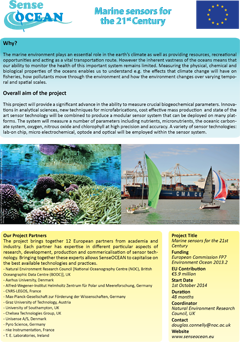Latest developments
Trials of a multi sensor suite developed by the SenseOCEAN project on a free-floating device were carried out off the coast of Villefranche sur Mer at the beginning of May. The multi sensor suite consisting of optode sensors (for pH and O2), an electrochemical sensor (Si) and a lab-on-chip sensor (NO3) was mounted on a PROVOR float and deployed in the Mediterranean Sea for a week.... more
A multi-optode-profiler carrying 18 O2 optodes separated in 3 revolver magazines allowing a successive use of the sensors during the deployment was successfully tested at the Arctic deep sea seafloor (RV Polarstern expedition PS 99.2). The new sensor system is mounted on a mobile autonomous crawler... more
During the first week of June, 2016, SenseOCEAN investigators Sergey Borisov the from Graz Institute of Technology, and Emilio Garcia-Robledo and Niels Peter Revsbech from Aarhus University tested their newly developed sensors in the marine waters of Limfjorden, Denmark. The optodes were tested for long-term monitoring of pH and CO2 in the coastal... more
Oxygen, pH and CO2 are among the most important parameters for marine measurements. The state-of-the-art devices for measurement of these parameters are bulky and expensive, and a separate device is necessary for measurement of each parameter. Therefore we are developing a modular, compact and cost-effective measurement system for all three parameters. The system is composed of a waterproof and... more
Researchers at Aarhus University have developed a new type of electrochemical microsensor for CO2 as part of the SenseOCEAN project. Usually both optical and electrochemical CO2 sensors are based on a change in pH when CO2 diffuses through an ion-impermeable membrane and into a buffer contained within the sensor, but this sensor reduces CO2 to oxalate resulting in a... more
One of the aims of SenseOCEAN is to ensure that the developed sensor package is low cost and mass producible. To achieve this, common systems must be adopted across the range of sensors including data management systems.
BODC (British Oceanographic Data Centre, NERC) have been working on the... more
 The second SenseOCEAN project... more
The second SenseOCEAN project... more
The silicate submersible sensor, developed by NKE-Instrumentation together with LEGOS-CNRS is a cylindrical sensor of 100mm diameter and 186mm height without the connector (230mm with connector) including a solenoid pump placed into a dielectric oil compartment and the electronics placed into a dry compartment. The “top” of the sensor, in equipressure, is the “technical part” with the 2 electrochemical cells... more
For phosphate detection, the challenge at the beginning of the SenseOCEAN project for CNRS-LEGOS was to adapt an electrochemical method other than chronoamperometry. Chronoamperomtry requires mechanical stirring of the solution which will not be possible in the final sensor for two reasons: the cell volume is too small and mechanical stirring costs too much energy. Cyclic voltammetry is not sensitive enough to... more
A 1st prototype of the silicate sensor developed by LEGOS-CNRS has been studied to determine its performance with respect to silicate detection. As shown in Figure 1, the prototype has 2 cells, the first one for the oxidation of the molybdenum and formation of the silicomolybdic complex (see earlier article). The complex is then... more
SenseOCEAN partner, LEGOS-CNRS develops miniaturized and autonomous electrochemical sensors to detect silicate and phosphate in sea water.
Because Silicate and Phosphate are non-electroactive species, it is not possible to detect them directly on metallic electrodes. However after complexation with molybdate... more
Aug 2015, Arjun Chennu
After months of preparation and careful execution, our dear hypersub system deployed in the Arctic coast was damaged by an iceberg (see previous article). We lost the chance to have our measurements continue into the winter, and perhaps also... more
Jan 2015, Arjun Chennu
The last few months have been somewhat mysterious. What had happened to hypersub? We deployed it at 17m depth up in the Arctic back in september (see previous article)... more
Oct 2014, Arjun Chennu
The hypersub observatory, developed at MPI Bremen, was tested in a pilot deployment in Helgoland back in May 2014 and approved for deployment in the Arctic. The target is an over-winter deployment on the underwater node of the... more
May 2014, Arjun Chennu
Hypersub is a novel observatory system developed at the Max Planck Institute for Marine Microbiology in Bremen (Fig 1). The flagship instrument of Hypersub is a hyperspectral imager which can be used to capture high-resolution (~1mm) spectral images of the seafloor over an area of 1 m... more













